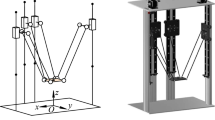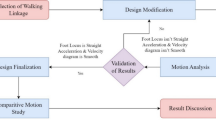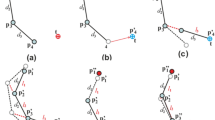Abstract
In this paper, we investigate the Degree of freedom (DOF), workspace and singularity of a wall climbing hexapod robot. The robot has two typical working modes, which are the six or three legs attaching on the wall, so robot can be regarded as 6SRRR or 3SRRR parallel mechanism, respectively. First, the DOF of the robot is analyzed by the screw theory. The result indicates that two configurations of the robot possess 6-DOF, and the screw theory makes the calculation of the DOF become extremely simple. Moreover, the workspace of the robot body is studied with constraint equations, which obtains the influence of structural parameters on workspace. After that, a new simple Jacobian matrix is proposed to analyze the singularity, and obtain the singular configurations of the robot, which greatly simplifies the calculation of Jacobian matrix of the robot. Finally, by experiments to verify that the singularity analysis method is correct. The singularity analysis of this paper could be applied for effective control of the robot to avoid singular configurations.
Similar content being viewed by others
References
K. Nagaya, T. Yoshino, M. Katayama, I. Murakami and Y. Ando, Wireless piping inspection vehicle using magnetic adsorption force, IEEE/ASME Transaction on Mechatronics, 17 (3) (2012) 472–479.
E. Sato, S. Iki, K. Yamanishi, H. Horibe and A. Matsumoto, Dismantlable adhesion properties of reactive acrylic copolymers resulting from cross-linking and gas evolution, The Journal of Adhesion, 7 (2016) 1–12.
G. Lee, H. Kim, K. Seo, J. Kim, M. Sitti and T. Seo, Series of multilinked caterpillar track-type climbing robots, Journal of Field Robotics, 33 (6) (2016) 737–750.
J. Jiang, Y. Zhang and S. Zhang, Implementation of glasscurtain-wall cleaning robot driven by double flexible rope, Industrial Robot: An International Journal, 41 (2014) 429–438.
Y. Liu, H. Kim and T. Seo, Anyclimb: A new wall-climbing robotic platform for various curvatures, IEEE/ASME Transaction on Mechatronics, 21 (3) (2016) 1812–1821.
Y. Liu, S. Sun, X. Wu and T. Mei, A wheeled wall-climbing robot with bio-inspired spine mechanisms, Journal of Bionic Engineering, 12 (1) (2015) 17–28.
F. Xu, J. Shen, J. Hu and G. Jiang, A rough concrete wallclimbing robot based on grasping claws: Mechanical design, analysis and laboratory experiments, International Journal of Advanced Robotic Systems, 10 (2016) 1–10.
S. Fujii et al., Ladder climbing control for limb mechanism robot “ASTERISK”, IEEE International Conference on Robotics and Automation, Pasadena, USA (2008) 3052–3057.
Z. Wang, X. Ding, A. Rovetta and A. Giusti, Mobility analysis of the typical gait of a radial symmetrical six-legged robot, Mechatronics, 21 (2011) 1133–1146.
M. C. García-López, E. Gorrostieta-Hurtado, E. Vargas-Soto, J. M. Ramos-Arreguín, A. Sotomayor–Olmedo and J. C. Moya Morales, Kinematic analysis for trajectory generation in one leg of a hexapod robot, Procedia Technology, 3 (2012) 342–350.
H. Zhang, Y. Liu, J. Zhao, J. Chen and J. Yan, Development of a bionic hexapod robot for walking on unstructured terrain, Journal of Bionic Engineering, 11 (2014) 176–187.
Z. Deng, Y. Liu, L. Ding, H. Gao, H. Yu and Z. Liu, Motion planning and simulation verification of a hydraulic hexapod robot based on reducing energy/flow consumption, Journal of Mechanical Science and Technology, 29 (10) (2015) 4427–4436.
D. Gan, J. Dai and D. G. Caldwell, Constraint based limb synthesis and mobility change aimed mechanism construction, ASME/Journal of Mechanical Design, 133 (5) (2011) 051001_1-051001_9.
X. Kong and C. M. Gosselin, Type synthesis of 3DOF spherical parallel manipulators based on screw theory, ASME/Journal of Mechanical Design, 126 (2004) 101–108.
J. Dai, Z. Huang and H. Lipkin, Mobility of overconstrained parallel mechanisms, ASME/Journal of Mechanical Design, 128 (2006) 220–229.
W. Bu, S. Yan, J Chen and X. An, Mobility analysis for parallel manipulators based on intersection of screw manifolds, Journal of Mechanical Science and Technology, 30 (9) (2016) 4345–4352.
J. P. Merlet, Direct kinematics and assembly modes of parallel manipulators, The International Journal of Robotics Research, 2 (1992) 150–162.
Z. Wang et al., A study on workspace, boundary workspace analysis and workspace positioning for parallel machine tools, Mechanism and Machine Theory, 5 (2001) 605–622.
Z. Gao, G. Wei and J. Dai, Inverse kinematics and workspace analysis of the metamorphic hand, Proc IMechE Part C: J. Mechanical Engineering Science (2014) 1–11.
M. Agheli and S. S. Nestinger, Closed-form solution for constant-orientation workspace and workspace-based design of radially symmetric hexapod robots, Journal of Mechanisms and Robotics, 6 (8) (2014) Doi: 10.1115/1.4026827.
D. Szep, S. Stan and V. Csibi, Design, workspace analysis, and inverse kinematics problem of delta parallel robot, Mechanika, 17 (3) (2011) 296–299.
R. Maldonado-Echegoyen, E. Castillo-Castaneda and M. A. Garcia-Murillo, Kinematic and deformation analyses of a translational parallel robot for drilling tasks, Journal of Mechanical Science and Technology, 29 (10) (2015) 4437–4443.
C. Gosselin, Determination of the workspace of 6 DOF parallel manipulators, Journal of Mechanical Design, 3 (1990) 331–336.
J. P. Merlet, Singular configurations of parallel manipulator and grassman geometry, The International Journal of Robotics Research, 5 (1989) 45–56.
J. Gallardo-Alvarado et al., Kinematics of an asymmetrical three legged parallel manipulator by means of the screw theory, Mechanism and Machine Theory, 45 (2010) 1013–1023.
D. Gan et al., Forward displacement analysis of a new 1CCC-5SPS Parallel mechanism using Grobner theory, Proc IMechE Part C: J. Mechanical Engineering Science, 223 (5) (2009) 1233–1241.
S. Zarkandi, Kinematics and singularity analysis of a parallel manipulator with three rotational and one translational DOFs, Mech. Based Des Struct. Mach., 39 (2011) 392–407.
J. Zhao, Y. Fu, K. Zhou and Z. Feng, Mobility properties of a Schoenflies-type parallel manipulator, Robotics and Computer Integrated Manufacturing, 22 (2006) 124–133.
D. Gan, J. Dai and D. Caldwell, Constraint-screw system based synthesis of limb arrangement of the 3-PUP parallel mechanism, J. Lenarcic and M. M. Stanisic (eds), Advances in robot kinematics: motion in man and machine, Dordrecht: Springer, 8 (2010) 485–492.
K. Xu and X. Ding, Typical gait analysis of a six-legged robot in the context of metamorphic mechanism theory, Chinese Journal of Mechanical Engineering, 4 (26) (2013) 771–783.
Author information
Authors and Affiliations
Corresponding author
Additional information
Recommended by Associate Editor Baek-Kyu Cho
Bin He received the B.S. degree in engineering machinery from Jilin University, Changchun, China, in 1996, and the Ph.D. degree in mechanical and electronic control engineering from Zhejiang University, Hangzhou, China, in 2001. Between 2001 and 2003, he held postdoctoral research appointments with The State Key Labof Fluid Power Transmission and Control, Zhejiang University. He is currently a Professor in the Department of Control Science and Engineering, College of Electronics and Information Engineering, Tongji University, Shanghai, China. His current research interests include intelligent robot control, neural networks, biomimetic microrobots, image processing and fusion, wireless communication, and wireless networks. Dr. He is an Associate Editor of Neurocomputing.
Shoulin Xu is currently working toward the Ph.D. degree in the Deparment of Control Science and Engineering, College of Electronics and Information Engineering, Tongji University. His research interests include mechanism of parallel manipulator, dynamics and control of robotic systems.
Yanmin Zhou is currently Assistant Professor in the Deparment of Control Science and Engineering, College of Electronics and Information Engineering, Tongji University. Her currently research interests include bionics, design and control of intelligent robot.
Zhipeng Wang received his Ph.D. degree from Tongji University in 2015. He is currently a post-doctoral in the School of Mechanical Engineering, Tongji University. His currently research interests include design, dynamics and control of robot.
Rights and permissions
About this article
Cite this article
He, B., Xu, S., Zhou, Y. et al. Mobility properties analyses of a wall climbing hexapod robot. J Mech Sci Technol 32, 1333–1344 (2018). https://doi.org/10.1007/s12206-018-0237-2
Received:
Revised:
Accepted:
Published:
Issue Date:
DOI: https://doi.org/10.1007/s12206-018-0237-2




